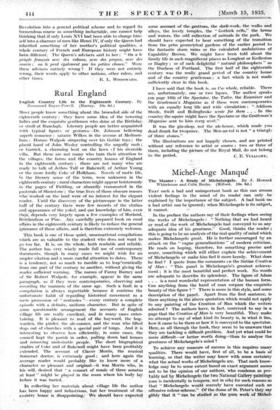Rural England
English Country Life in the Eighteenth Century. By Rosamond Bayne-Powell. (Murray. 10s. 6d.) Most. people know something about the brocaded side of the eighteenth century ; they have some idea of the towering ladies and the exquisite gentlemen who shine at the Birthday_ or stroll at Ranelagh. Literary people are better acquainted with typical figures or gestures—Dr. Johnson bellowing superb nonsense ; satanic Wilkes in the avenue at Medmen- ham ; Horace Walpole simpering over his Gothic toys ; the placid hand of John Wesley controlling the ungodly mob ; or Garrick, a charming host on the lawn a his riverside villa. But there arc not many who turn their attention to the villages, the farms and the country houses of England in the eighteenth century ; there are not many who are ready to talk of Jethro Tull or Bakewell, of Arthur Young or the more lordly Coke of Holkham. Novels of rustic life, in the literary sense of the term, were unknown in the eighteenth century ; rural characters might appear boisterously in '-the pages of Fielding, or absurdly transmuted in the pastorals of Shenstone ; the true, lives of those obscure masses Nvlio: worked on the land were of no interest for the elegant reader. Until the discovery of the picturesque in the latter flak of the century there were few records of the clothes and appearance of the yokel, and our knowledge of him, even
then; depends very largely upon a few examples of Morland, - Rowkindson or Pine. Any carefully prepared book on rural affairs in the eighteenth century is likely to reduce the general ignorance of those affairs, and is theiefore extremely welcome. . .
This book is one of those quiet, lmsensational compilations which are so valuable to the student who does not want to go .too far. It is, on the whole, both readable and reliable. The .author has very wisely made full use of contemporary documents, though in many cases we. might wish for an ampler citation and a more careful attention to dates. There is a tendency, not so much to ramble as to leap'erratically from .one part of the century to another, without giving the reader sufficient warning. The ,names of Fanny Burney and of Sir Robert Walpole, for example, appear in the same paragraph, as if they were contemporaries, observing and recording the manners of the same age. Such, a fault in a - compilation is always regrettable because it confirms the unfortunate habit of regareing historical movement as a mere -procession of "centuries "—every century a complete episode with a definite, uniform character. But in spite of• some questionable arrangement the accounts of English village life are really excellent, and in many cases enter- taining. It is pleasant to read of the hayward, the hog- warden, the pinder, the ale-conner, and the man who lifted dogs out of churches with a special pair of tongs. And it is interesting to observe how efficiently, in some cases, the council kept the parish in order, pulling -down bad houses and removing undesirable people. The short biographical studies of Coke and of Bakewell might have been profitably extended. The account of Claver Morris, the musical Somerset doctor, is extremely good ; and here again the average reader would probably like to know more of a character so pleasant and original—it was Morris who, in his -will, desired that a consort of music of three sonatas at least" might be played in the room where his body lay before it was buried.
In collecting her materials about village life the author hasl been happy and industrious, but her treatment of-the coabtry house is disappointing: We should have-expected
some account of the grottoes, the shell-work, the walks and alleys, the lovely temples, the " Gothick cells," the lawns and waters, the odd collection_ of animals in- the park. We should have expected to hear something of the transition from the prim geometrical gardens of the earlier period to the fantastic sham ruins or the calculated undulations of Capability Brown. We might have been told about the family life in such magnificent places as Longleat or Kedleston or Hagley ; or of such delightful "natural philosophers" as the Duchess of Portland. The first half of the eighteenth century was the really grand period of the country house and of the country gentleman ; a fact which is not made sufficiently clear in -this book.
I have said that the book is, on tie whole, reliable. There are, unfortunately, one or two lapses. The author speaks (on page 193) of the Spectator, the Taller, the Examiner and the Gentleman's Magazine as if these were contemporaries with an equally long life. and wide circulation : "Addison Steele, Swift and Bolingbroke wrote for them . . . In the country the squire might have the Spectator or the Gentleman's Magazine sent to him every week."
It was the gin-shop, not the ale-house, which made you dead drunk for twopence. The Men-an-tol is not "a triangla of three stones."
The illustrations are not happily chosen, and are printed without any reference to artist or source : two or three of them, including the picture of the Royal Mail, do not belong'










































 Previous page
Previous page